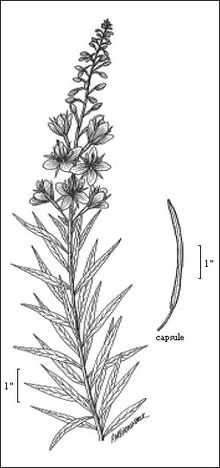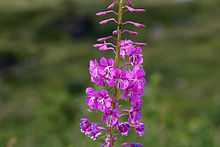Chamerion angustifolium
| Rosebay Willowherb or Fireweed | |
|---|---|
.JPG) | |
| Scientific classification | |
| Kingdom: | Plantae |
| (unranked): | Angiosperms |
| (unranked): | Eudicots |
| (unranked): | Rosids |
| Order: | Myrtales |
| Family: | Onagraceae |
| Genus: | Chamerion |
| Species: | C. angustifolium |
| Binomial name | |
| Chamerion angustifolium (L.) Holub | |
| Synonyms | |
|
Epilobium angustifolium (L.) | |
Chamerion angustifolium, commonly known as Fireweed (mainly in North America), Great Willow-herb (some parts of Canada),[1] or Rosebay Willowherb (mainly in Britain), is a perennial herbaceous plant in the willowherb family Onagraceae. It is native throughout the temperate of Northern Hemisphere, including large parts of the boreal forests.
This species has been placed in the genus Chamerion (sometimes, incorrectly, given as Chamaenerion) rather than Epilobium based on several morphological distinctions: spiral (rather than opposite or whorled) leaf arrangement; absence (rather than presence) of a hypanthium; subequal stamens (rather than stamens in two unequal whorls); zygomorphic (rather than actinomorphic) stamens and stigma. Under this taxonomic arrangement, Chamerion and Epilobium are monophyletic sister genera.[2]
Two subspecies are recognized as valid:
- Chamerion angustifolium ssp. angustifolium
- Chamerion angustifolium ssp. circumvagum
Etymology
The species name angustifolium is constructed from the Latin words angustus meaning 'narrow' and folium meaning 'leaf'. It shares this name with other species of plant including Vaccinium angustifolium.
Description
This herb is often abundant in wet calcareous to slightly acidic soils in open fields, pastures, and particularly burned-over lands; the name Fireweed derives from the species' abundance as a coloniser on burnt sites after forest fires. Its tendency to quickly colonize open areas with little competition, such as sites of forest fires and forest clearings, makes it a clear example of a pioneer species. Plants grow and flower as long as there is open space and plenty of light. As trees and brush grow larger the plants die out, but the seeds remain viable in the soil seed bank for many years; when a new fire or other disturbance occurs that opens up the ground to light again, the seeds germinate. Some areas with heavy seed counts in the soil can, after burning, be covered with pure dense stands of this species and when in flower the landscape is turned into fields of color.
In Britain the plant was considered a rare species in the 18th century,[3] and one confined to a few locations with damp, gravelly soils. It was misidentified as Great Hairy Willowherb in contemporary floras. The plant's rise from local rarity to widespread weed seems to have occurred at the same time as the expansion of the railway network, and the associated soil disturbance. The plant became locally known as bombweed due to its rapid colonization of bomb craters in the second world war.[3]

The reddish stems of this herbaceous perennial are usually simple, erect, smooth, 0.5–2.5 m (1½–8 feet) high with scattered alternate leaves. The leaves are entire, lanceolate, and pinnately veined. A related species, Dwarf Fireweed (Chamerion latifolium), grows to 0.3–0.6 m tall.
The radially symmetrical flowers have four magenta to pink petals, 2 to 3 cm in diameter. The styles have four stigmas, which occur in symmetrical terminal racemes.
The reddish-brown linear seed capsule splits from the apex. It bears many minute brown seeds, about 300 to 400 per capsule and 80,000 per plant. The seeds have silky hairs to aid wind dispersal and are very easily spread by the wind, often becoming a weed and a dominant species on disturbed ground. Once established, the plants also spread extensively by underground roots, an individual plant eventually forming a large patch.
The leaves of fireweed are unique in that the leaf veins are circular and do not terminate on the edges of the leaf, but form circular loops and join together inside the outer leaf margins. This feature makes the plants very easy to identify in all stages of growth. When fireweed first emerges in early spring, it can closely resemble several highly toxic members of the lily family, however, it is easily identified by its unique leaf vein structure.
Uses
The young shoots were often collected in the spring by Native American people and mixed with other greens. As the plant matures the leaves become tough and somewhat bitter. The southeast Native Americans use the stems in this stage. They are peeled and eaten raw. When properly prepared soon after picking they are a good source of vitamin C and pro-vitamin A. The Dena'ina add fireweed to their dogs' food. Fireweed is also a medicine of the Upper Inlet Dena'ina, who treat pus-filled boils or cuts by placing a piece of the raw stem on the afflicted area. This is said to draw the pus out of the cut or boil and prevents a cut with pus in it from healing over too quickly.

The root can be roasted after scraping off the outside, but often tastes bitter. To mitigate this, the root is collected before the plant flowers and the brown thread in the middle removed.
In Alaska, candies, syrups, jellies, and even ice cream are made from fireweed. Monofloral honey made primarily from fireweed nectar has a distinctive, spiced flavor.
In Russia, its leaves are used as tea substitute and were exported, known in Western Europe as Koporye Tea (Копорский чай) or Russian Tea. Fireweed leaves can undergo fermentation, much like real tea. Today, koporye tea is still occasionally consumed though not commercially important.
Chamerion angustifolium (Epilobium angustifolium) herb has been used in the traditional Austrian medicine internally as tea for treatment of disorders of the prostate, kidneys, and urinary tract.[4]
Fireweed's natural variation in ploidy has prompted its use in scientific studies of polyploidy's possible effects on adaptive potential[5] and species diversification.[6]
Habitat restoration
Because fireweed can colonize disturbed sites, even following an old oil spill, it is often used to reestablish vegetation. It grows in (and is native to) a variety of temperate to arctic ecosystems. Although it is also grown as an ornamental plant, some may find it too aggressive in that context.[7]
Depictions in human culture
Fireweed is the floral emblem of Yukon.
Rosebay Willowherb was voted the County flower of London in 2002 following a poll by the wild plant conservation charity Plantlife.[8]
Due to its pioneering properties rosebay willowherb was used by Terry Pratchett in his fictional Discworld novel Sourcery as the nearest comparative Roundworld flower to Sapient pearwood.[9]
Gallery
-
Seed capsule in Alpine Lakes Wilderness
-
Flower detail in Mount Baker-Snoqualmie National Forest
-

-

Stand of fireweed on recently burned location.
-

Fireweed near roadway in Alaska
-

Three plants by the Baltic sea
-

On the Klondike Highway in British Columbia
-

Fireweed seen from a helicopter: Interior Alaska
References
- ↑ ROM Field Guide to Wildflowers of Ontario, Royal Ontario Museum, Toronto:McClelland and Stewart Ltd., 2004.
- ↑ W. L. Wagner, P. C. Hoch, and P. H. Raven, 2007. Revised classification of the Onagraceae. Systematic Botany Monographs 83: 1-243.
- ↑ 3.0 3.1 Flora Britannica, Richard Mabey, ISBN 978-1-85619-377-1
- ↑ Vogl S, Picker P, Mihaly-Bison J, Fakhrudin N, Atanasov AG, Heiss EH,Wawrosch C, Reznicek G, Dirsch VM, Saukel J, Kopp B. Ethnopharmacological in vitro studies on Austria's folk medicine - An unexplored lore in vitro anti-inflammatory activities of 71 Austrian traditional herbal drugs. J Ethnopharmacol.2013 Jun13. doi:pii: S0378-8741(13)00410-8. 10.1016/j.jep.2013.06.007. [Epub ahead of print] PubMed PMID 23770053. http://www.ncbi.nlm.nih.gov/pubmed/23770053
- ↑ Martin, Sara L.; Husband, Brian C. (1 March 2013). "Adaptation of diploid and tetraploid Chamerion angustifolium to elevation but not local environment". Evolution. doi:10.1111/evo.12065. Retrieved 24 April 2013.
- ↑ Husband, Brian C. "University of Guelph Department of Integrative Biology, Dr. Brian C. Husband". Retrieved 24 April 2013.
- ↑ "Species: Chamerion angustifolium". Fire Effects Information System.
- ↑ Plantlife website County Flowers page
- ↑ Pratchett, Terry: Sourcery, page 65. Corgi, 1988
External links
 Media related to Chamerion angustifolium at Wikimedia Commons
Media related to Chamerion angustifolium at Wikimedia Commons- "Chamerion angustifolium". Integrated Taxonomic Information System.
- NCBI
- "Chamerion angustifolium (L.) Holub". Germplasm Resources Information Network (GRIN) online database. Retrieved 2012-10-05.
- Washington Flora Checklist
- Edible and Medicinal Plants of the West, Gregory L. Tilford, ISBN 0-87842-359-1
- Edibility of fireweed: Visual identification and edible parts of fireweed.


